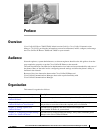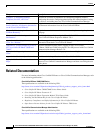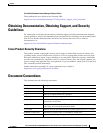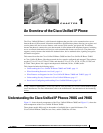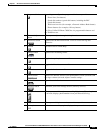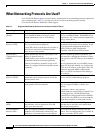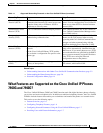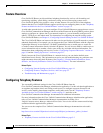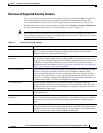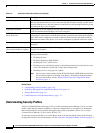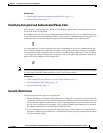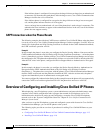
1-5
Cisco Unified IP Phone 7960G/7940G Administration Guide for Cisco Unified Communications Manager 7.0 (SCCP)
OL-15498-01
Chapter 1 An Overview of the Cisco Unified IP Phone
What Features are Supported on the Cisco Unified IP Phones 7960G and 7940G?
Related Topics
• Understanding Interactions with Other Cisco Unified IP Communications Products, page 2-2
• Understanding the Phone Startup Process, page 2-6
• Network Configuration Menu, page 4-4
What Features are Supported on the Cisco Unified IP Phones
7960G and 7940G?
The Cisco Unified IP Phones 7960G and 7940G function much like digital business phones, allowing
you to place and receive telephone calls. In addition to traditional telephony features, the Cisco Unified
IP Phone includes features that enable you to administer and monitor the phone as a network device.
This section covers the following topics:
• Feature Overview, page 1-6
• Configuring Telephony Features, page 1-6
• Configuring Network Parameters Using the Cisco Unified IP Phone, page 1-7
• Providing Users with Feature Information, page 1-7
Skinny Client Control
Protocol (SCCP)
SCCP includes a messaging set that allows
communications between call control servers and
endpoint clients such as IP Phones. SCCP is
proprietary to Cisco Systems.
Cisco Unified IP Phones use SCCP for call
control. You can configure the Cisco
Unified IP
Phone to use either SCCP or Session Initiation
Protocol (SIP).
Transmission Control
Protocol (TCP)
TCP is a connection-oriented transport protocol. Cisco Unified IP Phones use TCP to connect to
Cisco
Unified Communications Manager and to
access XML services.
Transport Layer
Security (TLS)
TLS is a standard protocol for securing and
authenticating communications.
When security is implemented, Cisco Unified IP
Phones use the TLS protocol when securely
registering with Cisco
Unified Communications
Manager and when communicating with the
Certificate Authority Proxy Function (CAPF).
Trivial File Transfer
Protocol (TFTP)
TFTP allows you to transfer files over the
network.
On the Cisco Unified IP Phone, TFTP enables
you to obtain a configuration file specific to the
phone type.
TFTP requires a TFTP server in your network,
which can be automatically identified from the
DHCP server. If you want a phone to use a TFTP
server other than the one specified by the DHCP
server, you must manually assign the IP address
of the TFTP server using the Network
Configuration menu on the phone.=
User Datagram Protocol
(UDP)
UDP is a connectionless messaging protocol for
delivery of data packets.
Cisco Unified IP Phones transmit and receive
RTP streams, which utilize UDP.
Table 1-1 Supported Networking Protocols on the Cisco Unified IP Phone (continued)
Networking Protocol Purpose Usage Notes



